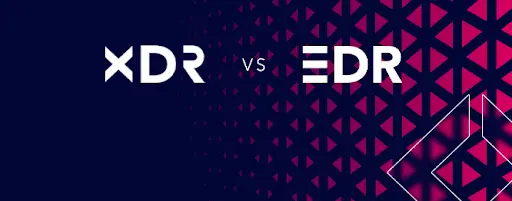Understanding the Difference and Choosing the Right Security Solution
With cyber threats becoming more sophisticated and frequent, it's important for businesses to have effective security solutions in place to detect, prevent, and respond to threats. Two popular security solutions are EDR (Endpoint Detection and Response) and XDR (Extended Detection and Response), but what is the difference between them and which one is right for your business? Let’s find out in this EDR vs XDR section
EDR solutions are focused on detecting and responding to threats on endpoints such as laptops, desktops, and servers. EDR solutions use advanced machine learning and behavioral analysis techniques to identify potential threats and provide real-time visibility into endpoint activity to help security teams quickly identify and respond to security incidents. EDR is a powerful tool for endpoint security, providing businesses with increased visibility into endpoint activity and potential security risks. EDR is also designed to protect against a wide range of endpoint threats, including malware, ransomware, zero-day attacks, and fileless attacks.
On the other hand, XDR solutions provide a more comprehensive approach to threat detection and response by integrating multiple security technologies such as EDR, NDR (Network Detection and Response), and CSPM (Cloud Security Posture Management) to detect and respond to threats across multiple environments. XDR provides businesses with enhanced threat detection and response capabilities across multiple environments, with reduced alert fatigue and improved security operations efficiency. With XDR, businesses can benefit from advanced analytics, automation, and orchestration capabilities, along with increased visibility and context into security incidents.
So, which solution is right for your business in this EDR vs XDR tussle? It depends on your specific security needs and requirements. If your business is primarily focused on endpoint security and has a limited security budget, EDR may be the better option. However, if your business operates in a complex and dynamic environment and requires a more comprehensive approach to threat detection and response, XDR may be the better choice.
In conclusion, EDR vs XDR is not a question of which one is better, but rather which one is better suited to your business needs. Both EDR and XDR are powerful security solutions that can help businesses protect against cyber threats and achieve better overall security posture. It's important to evaluate your business's security needs and requirements before choosing the right security solution for your business.
Which Security Solution is Right For Your Business?
Two security solutions play a vital role in improving the agility and effectiveness of cyber security for your organization. They are well-known as EDR and XDR. Today, I'm planning to share complete details of both solutions while letting you know EDR vs. XDR- which one is right for your business?
What is EDR vs XDR
EDR stands for Endpoint Detection and Response. It is an automated EDR software security tool that monitors, identifies, and mitigates threats at endpoints. This integrated security solution monitor endpoints in real-time.
It collects endpoint data and allows the security team to perform rapid threat analysis. This tool can initiate a rule-based automated response in case of suspicious activity.
More than 68 percents of Organizations are victims of endpoint threats.

XDR Stands for Extended Detection and Response.
It is a multi-layered detection and response tool that continuously captures, monitors, and analyzes data across multiple security layers such as servers, clouds, networks, endpoints, apps, etc. XDR helps your security team to detect, investigate and respond to threats.
Main Similarities
Before I tell you about the main differences between both solutions. I want to tell you how they are similar.
Quick Response
Response to threat matters the most. If you don't respond to an attack on time, an attack may be widespread and cause more damage to your organization. Thanks to Endpoint Detection Response and Extended Detection Response, you can enjoy a rapid response rate. Both EDR software security tools are automated, send alerts to security personnel, and start the remedy correctly.
Threat Detection Support
When your organization has both XDR and EDR, your cyber security analyst gets the much-needed resources to detect threats. Security teams enjoy excellent visibility into every endpoint, cloud app, system, and process. It becomes easy for them to figure out system vulnerabilities and loopholes. Thereby, your business can prevent cyber threats.
Proactive Security Solutions
XDR and EDR are the best alternatives to the traditional reactive approach. These solutions won't wait for a threat or infection in the system. They monitor your endpoint and network continuously for suspicious threats and activities. With the mean of these solutions, you can identify threats beforehand. It means you can manage the threats and eradicate them before it even causes any damage.
Main Differences
Here are some main points of difference between both cyber security tools.
Scope
EDR scope is limited. It only protects the endpoints of an organization. Contrary to this, XDR has a broader scope. It protects endpoints, emails, apps, cloud computing, and other solutions.
Visibility
EDR software won't protect your Organization from all cyber threats. It will only create a protective shield around endpoints. With this solution, your security team can only address the gaps and blindspots of endpoints. When you only have EDR, it offers limited visibility because EDR security analysts can look into all threat actors' actions.
However, XDR brings expanded protection where you can ward off all possible threats. Your team can have broader visibility into your digital environment, cloud, and endpoints. So, it lets Organizations fill the information gaps perfectly.
Solution integration
If your organization needs top-class endpoint protection, EDR is what does this job right. You will manually integrate EDR into a set of point solutions. Conversely, XDR offers a unified security solution where organizations can get unified visibility and threat protection. XDr simplifies the security architecture of an organization.
Technology
EDR software uses a behavior-based detection engine for the identification of unknown threats. On the other hand, XDR uses advanced endpoint and network rules alongside behavior-based detection engines for threat detection.
What's suitable for your Organization?
When choosing between XDR and EDR, your security experts must consider security architecture, types of security control, and computing environment.
When you need system and network comprehensive information, you will rely on XDR. However, when you need accurate data and information about endpoints, the detection and response tool is undoubtedly better than XDR.
You can have limited scope and visibility with EDR, but once you integrate XDR, it will let you enjoy broader system access and complete network protection.
In this digital transformation world, XDR lets organizations monitor and account for every step of the kill chain. Extended data and response tools are more than necessary because Organization relies heavily on cloud computing and remote work.
Remote workers have caused 20 percent of security breaches in organizations. Source
The Next-Level Protection
Even when your Organization has EDR, your Organization can get multiple benefits with the integration of XDR.
- It helps your security team detect attacks and vulnerabilities of the complete IT structure, not just endpoints.
- It decreases the chance of cyber threats
- It works as a unified platform that offers you incredible threat visibility in real time.
- It makes it simple for your Organization to manage, scale, and deploy risk and threats effectively.
In short, your Organization can enjoy higher productivity and lower cost of cyber security threats with the mean of XDR than EDR. It also offers better awareness and response capabilities.
Wrap up
Finally, you have got a clear picture of XDR vs. EDR in your mind. Both security solutions let your organization deal with cybersecurity threats. You can employ both to enjoy top-class protection across all endpoints and systems.
Whether you need EDR or XDR as your cyber security solution, Xcitium is here to help. We let Organizations monitor threats and respond to them automatically with our well-designed security solutions.
FAQ Section
EDR primarily focuses on protecting endpoints, providing detailed visibility and threat prevention for individual devices. XDR takes a broader perspective by integrating security across various components.
XDR builds upon the capabilities of traditional EDR products by incorporating telemetry from non-endpoint sources. XDR complements EDR by providing additional security insights and context from various sources.
EDR is an endpoint security solution that continuously monitors end-user devices to identify and respond to cyber threats such as ransomware and malware.
EDR tools can play a role in preventing ransomware attacks and protecting organizations from potential threats, especially in the early stages of an attack.
